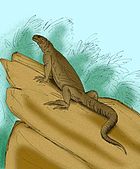Arretosauridae
 From Wikipedia the free encyclopedia
From Wikipedia the free encyclopedia
| Arretosauridae | |
|---|---|
| Scientific classification | |
| Domain: | Eukaryota |
| Kingdom: | Animalia |
| Phylum: | Chordata |
| Class: | Reptilia |
| Order: | Squamata |
| Suborder: | Iguania |
| Family: | †Arretosauridae Gilmore, 1943 |
| Genera | |
The Arretosauridae are an extinct family of iguanian lizards from the Paleogene of east-central Asia.[1][2]
Long represented only by a single genus (Arretosaurus), more recent studies indicate that they were far more diverse than previously assumed, with at least five different genera now known. Given their apparent diversity and abundance, they are thought to have been an important component of Paleogene Asian herpetofauna.[2]
Their exact taxonomic classification is debated; they are alternatively classified in either the Pleurodonta as a sister group to the North American Crotaphytidae (based on similar jaw features), or in the Acrodonta with the other Old World iguanians.[2][3]
The following genera are known:[1]
- †Arretosaurus Gilmore, 1943
- †Dornosaurus Alifanov 2012
- †Ergiliinsaurus Alifanov 2012
- †Hemishinisaurus Li, 1991
- †Khaichinguana Alifanov 2012
Fossils of the lizard Hoeckosaurus were previously thought to belong to arretosaurids, but more recent studies have assigned it to the Dibamidae.[4]
References[edit]
- ^ a b "Fossilworks: Arretosauridae". www.fossilworks.org. Retrieved 2 June 2023.
- ^ a b c Alifanov, V. R. (1 July 2012). "Lizards of the family Arretosauridae Gilmore, 1943 (Iguanomorpha, Iguania) from the Paleogene of Mongolia". Paleontological Journal. 46 (4): 412–420. Bibcode:2012PalJ...46..412A. doi:10.1134/S0031030112040028. ISSN 1555-6174. S2CID 119087759.
- ^ Bolet, Arnau; Stubbs, Thomas L; Herrera-Flores, Jorge A; Benton, Michael J (3 May 2022). Zhu, Min; Perry, George H; Zhu, Min (eds.). "The Jurassic rise of squamates as supported by lepidosaur disparity and evolutionary rates". eLife. 11: e66511. doi:10.7554/eLife.66511. ISSN 2050-084X. PMC 9064307. PMID 35502582.
- ^ Čerňanský, Andrej (13 August 2019). "The first potential fossil record of a dibamid reptile (Squamata: Dibamidae): a new taxon from the early Oligocene of Central Mongolia". Zoological Journal of the Linnean Society. 187 (3): 782–799. doi:10.1093/zoolinnean/zlz047. ISSN 0024-4082.
